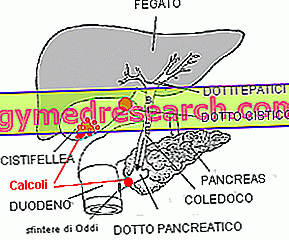Biliary colic
Acute cholecystitis (biliary colic) is the most frequent complication of lithiasis (presence of stones in the gallbladder and / or biliary tract). When moving from their home of origin, these solid agglomerates can in fact go to obstruct the normal flow of bile.

This condition generates intense pain, comparable to that experienced by women during labor.
The biliary colic is in fact characterized by a very violent pain that occurs in the upper part of the abdomen, in the center or more frequently to the right under the ribs; subsequently the pain extends posteriorly until it reaches the lower tip of the scapula.
In addition to being very painful, such an attack is also quite enduring since it can last from twenty to thirty minutes up to six to twelve hours. Often, due to its intensity, pain is associated with nausea, profuse sweating and vomiting.
Complications
Unfortunately, acute cholecystitis is not the only complication of gall bladder stones and not even the most serious.
Driven by contractions of the gallbladder, a calculus can in fact go down and obstruct the common bile duct (the main duct that carries bile into the duodenum). Initially this passage causes a pain that is completely similar to a banal colic. However, there is a fundamental difference between the two conditions: while in the case of simple colic, although the gallbladder is excluded, the passage of bile from the liver is still possible, in case of obstruction of the bile duct such outflow is prevented.
The inability to dispose of the bile that inevitably remains at the systemic level determines, with the passage of time, the classic aspect of the oitteric subject (yellow coloring of the skin and mucous membranes).
Bile stagnation can also infect the gallbladder filled with purulent material (pus). In this case we speak of empyema of the gallbladder .
Unfortunately, the terminal tract of the choledochus narrows and is regulated by the presence of a sphincter, a sort of muscular ring that controls the passage of organic fluids. For this reason the calculation will hardly be able to pass this barrier. His stay in this area, in addition to preventing the biliary outflow, also hinders the passage of the juices produced by the pancreas. The consequent rise of bile in the pancreatic duct, associated with the sudden increase in pressure in the more internal ducts can trigger acute pancreatitis (30-70% of cases, more frequent in women after 50-60 years).
On the other hand, if a large calculus pierces the wall of the common bile duct and the duodenum, wedging itself into the latter, an intestinal obstruction may occur.
Diagnosis

The ultrasound of the upper abdomen is the simplest and most reliable type of diagnostic investigation. It allows the visualization of the calculations (even if they are not radiopaque), the state of the gall bladder wall and any dilations and / or calculations of the main bile duct (a conduit that carries bile directly from the liver to the intestine). Furthermore, this test, unlike the old cholecystography, does not give any radiation to the patient and is totally devoid of other side effects.
In the presence of atypical symptoms, other pathologies affecting the digestive tract (peptic ulcer; gastroesophageal reflux; irritable bowel syndrome; etc.) should be excluded.
The ultrasound examination does not require the observance of particular preparations for the exam except fasting for at least 6/8 hours and, possibly, a diet poor in waste in the previous two or three days. In this way we try to prevent intestinal meteorism, one of the main factors that hinder the diagnosis.



